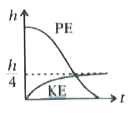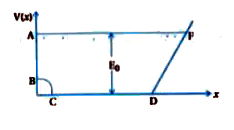A raindrop falling from a height h above ground , attains a near terminal velocity when it has fallen through a height (34) h . Which f the diagrams shown in figure correctly shows the change in kinetic and potential energy of the drop during its fall up to the ground ?Solution in Gujrati




The correct Answer is:B
When drop falls its velocity increases and KE also increases . After sometime velocity becomes constant called terminal velocity ,hence KE also becomes constnt . PE decreases consistently as the drop is falling .
The fluctuation in PE and KE is represented by
Topper's Solved these Questions
- WORK, ENERGY AND POWER BOOK - KUMAR PRAKASHANCHAPTER - WORK, ENERGY AND POWER EXERCISE - SECTION - D NCERT Exemplar Solutions (Very Short Answer Type Questions)
12 Videos
- WORK, ENERGY AND POWER BOOK - KUMAR PRAKASHANCHAPTER - WORK, ENERGY AND POWER EXERCISE - SECTION - D NCERT Exemplar Solutions (Short Answer Type Questions)
10 Videos
- WORK, ENERGY AND POWER BOOK - KUMAR PRAKASHANCHAPTER - WORK, ENERGY AND POWER EXERCISE - SECTION - C Objective Questions (VSQs)
52 Videos
- WAVESBOOK - KUMAR PRAKASHANCHAPTER - WAVESEXERCISE - SECTION-F (Questions From Module) (Sample questions for preparation of competitive exams)
23 Videos
Similar Questions
A through inclined is placed on car moving with a constant velocity u on horizontal ground . A block of mass M rests on the inclined plane . Is any work done by force of friction then a dissipation of energy ?
View SolutionA graph of potential energy V(x) verses x is shown in figure .A particle of energy E0 is executing motion in it . Draw graph of velocity and kinetic energy verses x for one complete cycle AFA.

View SolutionIf →A=2ˆi−2ˆjand→B=2ˆk then →A.→B……
View SolutionIn a standing wave formed by two atoms separated by 1.21Å, there are 3 nodes and 2 antinodes. Find its wavelength.
View SolutionA raindrop falling from a height h above ground, attains a near terminal velocity when it has fallen through a height (3//4)h . Which of the diagrams shown the change in kinetic and potential energy of the drop during its fall up to the ground ?
View SolutionA raindrop falling from a height h above ground, attains a near terminal velocity when it has fallen through a height (3/4)h. Which of the diagrams shown in figure correctly shows the change in kinetic and potential energy of the drop during its fall up to the ground ?
View SolutionA ball of mass m is dropped from a cliff of height H. The ratio of its kinetic energy to the potential energy when it is fallen through a height 3/4 H is
View SolutionA raindrop of radius r falls from a certain height h above the ground. The work done by the gravitational force is proportional to :
View SolutionA ball is dropped vertically, from a height h above the ground. It hits the ground and bounces up vertically to a height h/2. Neglecting subsequent motion and air resistance, its velocity v varies with the height h as
View Solutionm द्रव्यमान की एक गेंद को H ऊँचाई की एक पहाड़ी से गिराया जाता है। 34 की ऊँचाई से गिरने पर इसकी गतिज ऊर्जा का स्थितिज ऊर्जा से अनुपात होगा-
View Solutionजमीन से h ऊँचाई पर से गिरती हुई बारिश की एक बूंद, सीमांत वेग के लगभग वेग को तब प्राप्त करती है जब यह की (34)h ऊँचाई से गिरती है। चित्रों में दिखाए गए में से कौन-सा आरेख बूंद के इसके जमीन पर गिरते समय गतिज व स्थितिज ऊर्जा में परिवर्तन को दर्शाता है?
View SolutionA raindrop falling from a height .h. above ground, attains a near terminal velocity when it has fallen through a height (3/4)h. Which of the diagrams shown below correctly shows the change in kinetic and potential energy of the drop during its fall up to the ground ?
View Solutionbody is allowed to fall from a height h above the ground. Then match the following
View Solution. A raindrop falling from a height .h. above ground, attains a near terminal velocity when it has fallen through a height (3/4)h. Which of the diagrams shown below correctly shows the change in kinetic and potential energy of the drop during its fall up to the ground?
View SolutionWhen a body is projected vertically up from ground, the ratio of its potential to kinetic energies at a height .h. above the ground is 3:4. The height above ground at which the ratio of potential to kinetic energies becomes 4:3 is
View Solution
